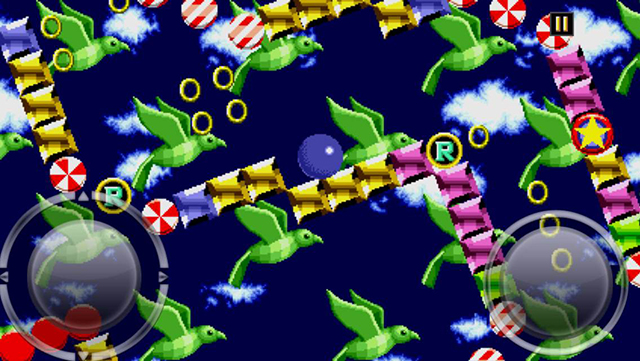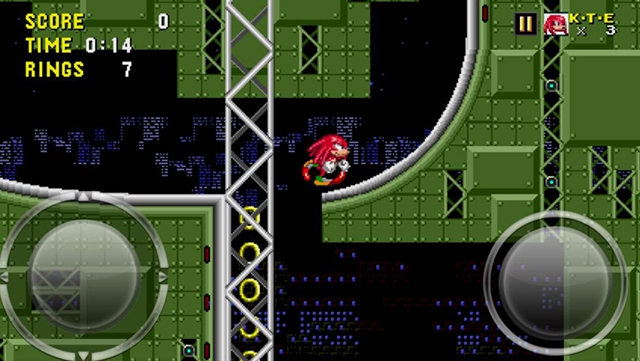Sonic The Hedgehog Review
Released in 1991, Sonic The Hedgehog is possibly one of the most influential games ever made, and stars one of the few characters in gaming that ever gave Mario any sort of challenge to his platforming crown. Sonic Team’s Mega Drive classic has found it’s way to practically every major console since SEGA’s withdrawal from hardware development back in 2001.
The first game in the series has already made an appearance on iOS devices, and this newly remastered version is a free update for those who already own that version of the game (plus, this version is now on Android). Similar to last year’s repackaging of Sonic CD on console and mobile devices, this version was rewritten from scratch by Christian Whitehead, using his own Retro Engine, meaning this version has been coded with modern systems in mind.
In this first chapter of Sonic’s adventures, he must rescue his woodland friends from being turned into evil robots, courtesy of one Dr. Ivo Robotnik (the egg-obsessed scientist who would later be known worldwide as his Japanese moniker, Eggman). Sonic starts in the iconic Green Hill Zone, making his way to Robotnik’s base in the Scrap Brain Zone.

This game is Sonic in its purest form; that is to say, without the intervention of his irritating friends (that would find their way into later games) and while maintaining the sublime balance of speed and exploration that set SEGA’s hero apart from other platformers of the 16-bit era.
A range of memorable locales await Sonic, from the Green Hill Zone to the pinball-like neon wonderland of Spring Yard Zone. There are areas that offer the chance to reach exhilarating speeds and others that require a bit of care to navigate. Multiple boss-fights occur, against Robotnik and his many contraptions that require memorisation of attack patterns, and can still trip up even the most experienced players. Even over two decades later, this game hasn’t aged one bit and is still a must-play title for any gamer, young or old.
While the game itself won’t take that long to finish, especially when you consider that this version allows you to save progress after every stage, there are unlockable characters in the form of two-tailed fox, Miles “Tails” Prower and the unnaturally-magenta Knuckles The Echidna. Tails has his ability to fly over short distances, while Knuckles can glide and climb up walls. These additional characters don’t add to much to the game, but they’re nice bonuses considering this facility wasn’t even made available through the Lock-On functionality provided by the 1994 release of Sonic & Knuckles. All three characters are also able to use the Spin Dash move, which wasn’t available in the previous game.
This version also includes Time Trials, Leaderboards and Achievements that add a fair amount of replay value for the expert Sonic The Hedgehog player, something that was never available for the original game and is always a welcome addition.

Now, the big question with this version of the game is whether or not the on-screen touch controls work. While it’s true that touch controls never feel as responsive or as accurate as physical controls, this version does give you the option to choose how large you want the on-screen D-Pad and jump button to be, which makes the controls a little more effective. It’s not perfect, of course, and isn’t always up to the responsiveness you need for a game as quick as this, but it’s an improvement over similar ports of retro games.
The presentation of this game is impeccable, with a clean menu system and even the option to choose which box and cartridge art appears (the Japanese, European or American). It’s a little thing that doesn’t impact anything, but it’s a nice touch.
But the biggest change this Retro Engine-improved version of the game brings is an all-new widescreen presentation. On iOS it supports the full aspect ratio of the iPhone 5’s Retina screen, and everything is redrawn to fit the new screen proportions, without stretching or losing clarity. Everything is pixel perfect and running at a full 60 frames per second without a dropped frame in sight, as it should be. It’s simply the best that the original game has ever looked (I haven’t seen the upcoming 3D-enabled 3DS port of Sonic yet, so I can’t comment on how it compares).

The audio is also perfect. The biggest challenge in emulating the Mega Drive is it’s Yamaha-developed YM2612 sound chip that outputs a distinctive FM synthesised sound. Sound quality differs even between the different modes of original hardware, which is why it’s great to hear that this remastered version sounds even better than on an original console. With no buzzing, and with instruments that sound like they did on the Mega Drive, it just sounds right.
VERDICT: This version of a classic game is absolutely brilliant. Once again, Christian Whitehead’s Retro Engine goes beyond mere emulation to provide an unparalleled retro experience. While the biggest stumbling block is whether or not you can live with on-screen virtual controls, this is the definitive version of Sonic The Hedgehog, and like the previously released Sonic CD, I’d love to see a console version of this. You may already own Sonic for a number of consoles, but if for some reason you don’t or you would like a more mobile version, this could be right up your street.
I hope that SEGA and other publishers look into using the Retro Engine for future re-releases of retro games (not just Sonic), as the results are far more impressive than any emulation.

SUPERB. This is the mark of greatness, only awarded to games that engage us from start to finish. Titles that score 9/10 will have very few problems or negative issues, and will deliver high quality and value for money across all aspects of their design.




